A Study on Spatiotemporal Dynamics and Spatial Dependence of Sound Source Perception in Fuzhou Historical and Cultural Districts
Abstract
1. Introduction
2. Data Sources and Processing
2.1. Sample Plot Overview
2.2. Data Sources
2.2.1. Soundscape Monitoring Data
2.2.2. Soundscape Perception Data
2.3. Data Processing
2.3.1. Comprehensive Evaluation Indicators for Soundscape Perception
2.3.2. Spatial Analysis of Soundscape Perception Features
- Global spatial autocorrelation
- 2.
- Local spatial autocorrelation
- 3.
- Spatial relationship between physical sound level and soundscape perception
3. Results and Analysis
3.1. Characterization of Spatial and Temporal Patterns of Physical Acoustic Indicators
3.1.1. Characterization of the Spatial Distribution of Physical Acoustic Indicators
3.1.2. Time-Varying Characteristics of Physical Acoustic Indicators
3.2. Spatial Distribution Pattern of Sound Source Harmony
3.2.1. Characteristics of the Spatial Distribution of Sound Source Harmony
3.2.2. Global Spatial Dependence of Sound Source Harmony
3.2.3. Local Spatial Dependence of Sound Source Harmony
3.3. Spatial Relationship between Physical Acoustic Indicators of the Soundscape and the Perceived Sound Source Harmony
4. Discussion
4.1. Spatial and Temporal Variations of Physical Acoustic Indicators in the Three Square and Seven Alleys
4.2. Spatial Distribution Patterns of Sound Source Harmony in the Three Square and Seven Alleys
4.3. Spatial Relationship between Physical Acoustic Indicators and Sound Source Harmony in the Three Square and Seven Alleys
4.4. Limitations and Prospects
5. Conclusions
Author Contributions
Funding
Data Availability Statement
Conflicts of Interest
References
- Feng, G. Why should sound cities have memories? Chongqing Archit. 2005, 6. [Google Scholar]
- Zhao, Z.Y.; Li, Z. Street life: A study of healing places in historic districts in urban renewal. Art Des. Res. 2024, 1, 88–93. [Google Scholar]
- Lin, Y.; Xuan, Y.; Guo, H. Cultural Space Creation in Historic Neighbourhoods from an Operational Perspective: The Case of Sanfangqixiang in Fuzhou City. Urban Archit. 2023, 20, 65–68. [Google Scholar] [CrossRef]
- Xiao, M.; Guo, J.; Zhao, X. A preliminary study on the spatial and temporal differentiation of soundscape in the historical and cultural neighbourhood of Jianghan Road, Wuhan. Cent. China Archit. 2023, 41, 35–40. [Google Scholar]
- Cao, J.; Kang, J. A Perceptual Structure of Soundscapes in Urban Public Spaces Using Semantic Coding Based on the Grounded Theory. Int. J. Environ. Res. Public Health 2023, 20, 2932. [Google Scholar] [CrossRef] [PubMed]
- Xie, H.; He, Y.; Liu, C. A study on the renewal design strategy of historic districts under the intervention of soundscape: The case of the old street of Danzishi in Chongqing. Mod. Urban Res. 2021, 10, 55–62. [Google Scholar]
- Hu, X.; He, J. in Soundscape Application for the Conservation and Vibrant Revival of Historical and Cultural Neighbourhoods—Taking Changsha Taiping Old Street as an Example. In Proceedings of the 2019 Architectural Society of China Architectural History Branch Annual Meeting and Symposium, Beijing, China, 8–10 November 2019; p. 4. [Google Scholar]
- Chen, M.-C.; Wu, W.-L.; Qu, G.-C. Research on the protection and optimization of soundscape heritage based on subject-object perception: A case study of Huishan Ancient Town, Wuxi. China Famous City 2021, 35, 65–70. [Google Scholar] [CrossRef]
- Liu, J.; Yang, L.; Zhang, X. A study on the relationship between soundscape perception and landscape evaluation of historical neighbourhoods—A case study of Sanfangqixiang, Fuzhou. Chin. Gard. 2019, 35, 35–39. [Google Scholar]
- Qin, Y. Scope of soundscape. In Proceedings of the Ninth National Conference on Building Physics, Nanjing, China, 15–17 October 2004. [Google Scholar]
- Wang, J.; Jia, L. A study of living street soundscape in Chengdu from the perspective of cultural heritage. Urban Archit. 2022, 19, 177–182. [Google Scholar] [CrossRef]
- Hong, J.Y.; Ong, Z.; Lam, B.; Ooi, K.; Gan, W.; Kang, J.; Feng, J.; Tan, S. Effects of adding natural sounds to urban noises on the perceived loudness of noise and soundscape quality. Sci. Total Environ. 2020, 711, 134571. [Google Scholar] [CrossRef]
- Aletta, F.; Kang, J.; Axelsson, Ö. Soundscape descriptors and a conceptual framework for developing predictive soundscape models. Landscape Urban Plan. 2016, 149, 65–74. [Google Scholar] [CrossRef]
- Northwestern Polytechnical University; Zhejiang University; Tongji University; Chongqing University; Institute of Acoustics, Chinese Academy of Sciences; Zhejiang Institute of Science and Technology; Guangdong Qiyuan Architectural Engineering Design Institute Co. Acoustics Soundscape Part 1: Definitions and conceptual framework. In State Administration for Market Supervision and Regulation; National Committee for Standardisation: Beijing, China, 2014. [Google Scholar]
- Jo, H.I.; Jeon, J.Y. Effect of the appropriateness of sound environment on urban soundscape assessment. Build. Environ. 2020, 179, 106975. [Google Scholar] [CrossRef]
- Xu, X.; Zhuang, A.; Han, F. Effects of dominant tones on perceived emotions of soundscapes in nature conservation sites—A case study of Wulingyuan World Heritage Site. Chin. Gard. 2019, 35, 28–33. [Google Scholar] [CrossRef]
- Yuting, Y.; Yuhan, S.; Huilin, L.; Yiying, H.; Like, J. Predicting and Visualizing Human Soundscape Perception in Large-Scale Urban Green Spaces: A Case Study of the Chengdu Outer Ring Ecological Zone. Forests 2023, 14, 1946. [Google Scholar] [CrossRef]
- Aletta, F.; Kang, J. Soundscape approach integrating noise mapping techniques: A case study in Brighton, UK. Noise Mapp. 2015, 2, 1–12. [Google Scholar] [CrossRef]
- Wang, Y.; Yin, C.; Ni, X.; Wang, Y. Experimental study on soundscape and audiovisual perception in urban historic districts. Appl. Acoust. 2020, 39, 104–111. [Google Scholar]
- Rui, Q.X.; Zhao, W. In Winter and Summer Differences in Soundscape Perception for Landscape Evaluation of Historical and Cultural Neighbourhoods—A Case Study of Central Avenue. In Proceedings of the 2021 Annual Meeting of the Chinese Society of Landscape Architecture, Changsha, China, 15–17 April 2021; p. 4. [Google Scholar]
- Jeon, J.Y.; Hong, J.Y. Classification of urban park soundscapes through perceptions of the acoustical environments. Landsc. Urban Plan 2015, 141, 100–111. [Google Scholar] [CrossRef]
- Efstathios, M.; Jian, K.; Francesco, A.; Östen, A. On the relationship between land use and sound sources in the urban environment. J. Urban Des. 2020, 25, 626–642. [Google Scholar] [CrossRef]
- Liu, J.; Kang, J.; Luo, T.; Behm, H.; Coppack, T. Spatiotemporal variability of soundscapes in a multiple functional urban area. Landsc. Urban Plan 2013, 115, 1–9. [Google Scholar] [CrossRef]
- Hong, J.Y.; Jeon, J.Y. Influence of urban contexts on soundscape perceptions: A structural equation modeling approach. Landsc. Urban Plan 2015, 141, 78–87. [Google Scholar] [CrossRef]
- Zhu, C.; TianYuan, Z.; Jiang, L.; XinChen, H. Before Becoming a World Heritage: Spatiotemporal Dynamics and Spatial Dependency of the Soundscapes in Kulangsu Scenic Area, China. Forests 2022, 13, 1526. [Google Scholar] [CrossRef]
- Rychtáriková, M.; Vermeir, G. Soundscape categorization on the basis of objective acoustical parameters. Appl. Acoust. 2013, 74, 240–247. [Google Scholar] [CrossRef]
- Hong, J.Y.; Jeon, J.Y. Exploring spatial relationships among soundscape variables in urban areas: A spatial statistical modelling approach. Landsc. Urban Plan 2017, 157, 352–364. [Google Scholar] [CrossRef]
- Pan, S. Ruminations on the Conservation and Development of Three Square and Seven Alleys in Fuzhou. Dev. Res. 2004, 10, 72–73. [Google Scholar]
- Guo, T.; Yang, L.; Gui, Y.; Zhu, T.; Liu, J.; Ren, W. Research on the influencing factors of placemaking in historic districts under soundscape perception. Acoust. Technol. 2022, 41, 108–115. [Google Scholar]
- Chen, L.; Fang, K.; Wang, X.; Zhang, W.; Zhu, G.; Zhang, Z.; Furuya, N. The spatial feature and use pattern of external space in Chongqing traditional urban settlement. J. Asian Archit. Build. 2022, 22, 125–138. [Google Scholar] [CrossRef]
- Liu, K. Soundscape design in city parks: Exploring the relationships between soundscape composition parameters and physical and psychoacoustic parameters. J. Environ. Eng. Landsc. 2015, 23, 102–112. [Google Scholar] [CrossRef]
- Weijters, B.; Geuens, M.; Baumgartner, H. The Effect of Familiarity with the Response Category Labels on Item Response to Likert Scales. J. Consum. Res. 2013, 40, 368–381. [Google Scholar] [CrossRef]
- Jing, M.; Wu, J. Fast image interpolation using directional inverse distance weighting for real-time applications. Opt. Commun. 2013, 286, 111–116. [Google Scholar] [CrossRef]
- Liu, J.; Xiong, Y.; Wang, Y.; Luo, T. Soundscape effects on visiting experience in city park: A case study in Fuzhou, China. Urban Urban Gree 2018, 31, 38–47. [Google Scholar] [CrossRef]
- Liu, J.; Zhu, T.; Hong, X. Spatio-temporal dynamics and spatial dependence characteristics of sound source perception in urban forest parks. Chin. Gard. 2022, 38, 64–69. [Google Scholar]
- Lei, J.; Chen, Z.; Chen, Y.; Chen, X.; Li, Y.; Wu, T. Evolution of ecological security pattern of wetland landscapes on Hainan Island, 1990–2018. J. Ecol. Environ. 2020, 29, 293–302. [Google Scholar]
- Ricciardi, P.; Delaitre, P.; Lavandier, C.; Torchia, F.; Aumond, P. Sound quality indicators for urban places in Paris cross-validated by Milan data. J. Acoust. Soc. Am. 2015, 138, 2337. [Google Scholar] [CrossRef]
- Yong, J.J.; Young, H.J.; Jik, L.P. Soundwalk approach to identify urban soundscapes individually. J. Acoust. Soc. Am. 2013, 134, 803–812. [Google Scholar] [CrossRef]
- Negreiros, J.G.; Painho, M.T.; Aguilar, F.J.; Aguilar, M.A. A comprehensive framework for exploratory spatial data analysis: Moran location and variance scatterplots. Int. J. Digit. Earth 2010, 3, 157–186. [Google Scholar] [CrossRef]
- Wang, Y.; Ji, Y.; Yu, H.; Lai, X. Measuring the Relationship between Physical Geographic Features and the Constraints on Ecosystem Services from Urbanization Development. Sustainability 2022, 14, 8149. [Google Scholar] [CrossRef]
- Guo, A.; Yang, J.; Sun, W.; Xiao, X.; Cecilia, J.X.; Jin, C.; Li, X. Impact of urban morphology and landscape characteristics on spatiotemporal heterogeneity of land surface temperature. Sustain. Cities Soc. 2020, 63, 102443. [Google Scholar] [CrossRef]
- Rogerson, P.A. Optimal geographic scales for local spatial statistics. Stat. Methods Med. Res. 2011, 20, 119–129. [Google Scholar] [CrossRef]
- Hu, J.; He, P. Spatial and temporal coupling and coordination between new urbanization and agricultural green development in China. J. Party Sch. Yunnan Prov. Comm. Communist Party China 2024, 25, 125–139. [Google Scholar]
- Zeng, J.; Yin, M.; Xu, J. Study on the spatial coupling relationship between urban residential price distribution and public service facilities—A comparative analysis of second-hand and rental housing in central Nanjing as an example. In Proceedings of the 2022/2023 China Annual Conference on Urban Planning, Wuhan, China, 23–25 September 2023. [Google Scholar]
- Gu, Q.; Geng, G.; Zheng, R.; Zhang, B.; He, Z. Analysis of spatial and temporal variation of soil moisture and its influencing factors in the Weihe River Basin. Soil Water Conserv. Res. 2024, 1–13. [Google Scholar] [CrossRef]
- Zhao, X.; Zhang, S.; Meng, Q.; Kang, J. Influence of Contextual Factors on Soundscape in Urban Open Spaces. Appl. Sci. 2018, 8, 2524. [Google Scholar] [CrossRef]
- Sheng, F.; Guo, S.; Lin, G.; Wen, M. Vibrant Spaces of Historical and Cultural Neighbourhoods Based on Open Big Data—A Case Study of Sanfangqixiang in Fuzhou. In Proceedings of the 2022/2023 China Annual Conference on Urban Planning, Wuhan, China, 23–25 September 2023; p. 9. [Google Scholar]
- Wang, X.; Wang, S.; Xue, Y. Analysis of spatial use and main factors of historic districts: The case of Sanfangqixiang. Res. Nat. Cult. Herit. 2023, 8, 13–22. [Google Scholar] [CrossRef]
- Weifu, G.; Jian, K.; Hui, M.; Chao, W. The effects of environmental sensitivity and noise sensitivity on soundscape evaluation. Build. Environ. 2023, 245, 110945. [Google Scholar] [CrossRef]
- Ednie, A.; Gale, T. Soundscapes and protected area conservation: Are noises in nature making people complacent? Nat. Conserv. 2021, 44, 177–195. [Google Scholar] [CrossRef]
- Ye, J.; Zheng, J.; Wang, H.; Zheng, Y. Evaluation of acoustic landscape preferences in wetland parks. Acoust. Technol. 2022, 41, 734–741. [Google Scholar]
- Hong, J.Y.; Jeon, J.Y. Comparing associations among sound sources, human behaviors, and soundscapes on central business and commercial streets in Seoul, Korea. Build. Environ. 2020, 186, 107327. [Google Scholar] [CrossRef]
- Ye, J.; Li, S.; Chen, Y.; Ma, Y.; Chen, L.; He, T.; Zheng, Y. A Study of the Effects of Historical Block Context on Soundscape Perception. Buildings 2024, 14, 621. [Google Scholar] [CrossRef]
- Lee, H.M.; Lee, H.P.; Liu, Z. Acoustical Environment Studies in the Modern Urban University Campuses. Acoustics 2022, 4, 14–25. [Google Scholar] [CrossRef]
- Ye, J.; Chen, L.; Zheng, Y. Effect of an Artificial Sound-Based Index on the Perception of Historical Block Environments. Buildings 2023, 13, 2372. [Google Scholar] [CrossRef]
- Zhao, Z.; Wang, Y.; Hou, Y. Residents’ Spatial Perceptions of Urban Gardens Based on Soundscape and Landscape Differences. Sustainability 2020, 12, 6809. [Google Scholar] [CrossRef]
- Pérez-Martínez, G.; Torija, A.J.; Ruiz, D.P. Soundscape assessment of a monumental place: A methodology based on the perception of dominant sounds. Landsc. Urban Plan 2018, 169, 12–21. [Google Scholar] [CrossRef]
- Zhang, D.; Zhang, M.; Liu, D.; Kang, J. Soundscape evaluation in Han Chinese Buddhist temples. Appl. Acoust. 2016, 111, 188–197. [Google Scholar] [CrossRef]
- Bruce, N.S.; Davies, W.J. The effects of expectation on the perception of soundscapes. Appl. Acoust. 2014, 85, 1–11. [Google Scholar] [CrossRef]
- Liu, K.; Behm, L. Landscape spatial pattern indices and soundscape perception in a multi-functional urban area, Germany. J. Environ. Eng. Landsc. 2014, 22, 208–218. [Google Scholar] [CrossRef]
- Bittencourt, L.; Barbosa, M.; Bisi, T.L.; Lailson-Brito, J.; Azevedo, A.F. Anthropogenic noise influences on marine soundscape variability across coastal areas. Mar. Pollut. Bull. 2020, 160, 111648. [Google Scholar] [CrossRef] [PubMed]
- Pelletier, C.; Weladji, R.B.; Lazure, L.; Paré, P. Zoo soundscape: Daily variation of low-to-high-frequency sounds. Zoo. Biol. 2020, 39, 374–381. [Google Scholar] [CrossRef] [PubMed]
- Li, L.; Li, Y.; Li, Z. Efficient missing data imputing for traffic flow by considering temporal and spatial dependence. Transp. Res. Part C 2013, 34, 108–120. [Google Scholar] [CrossRef]
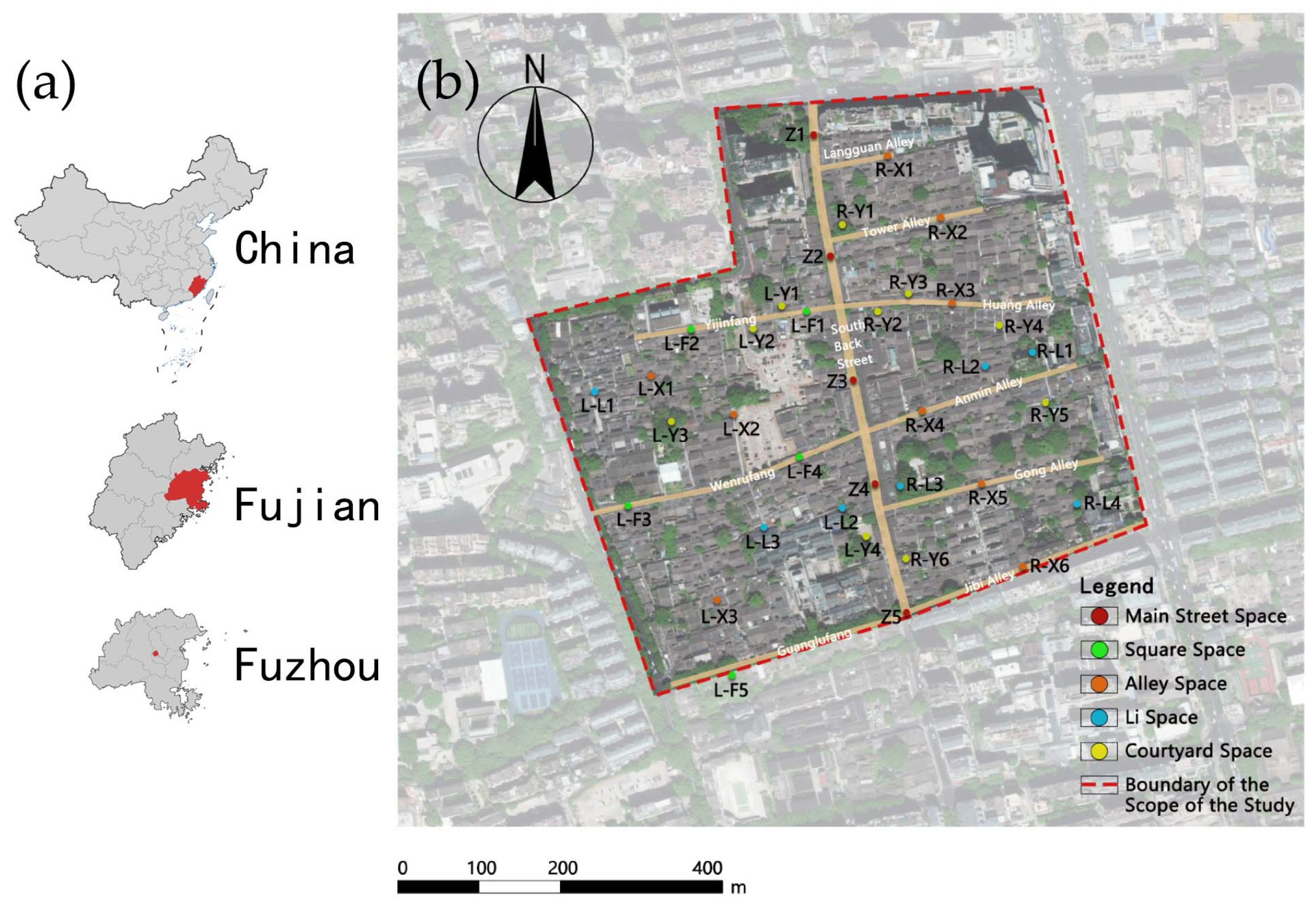
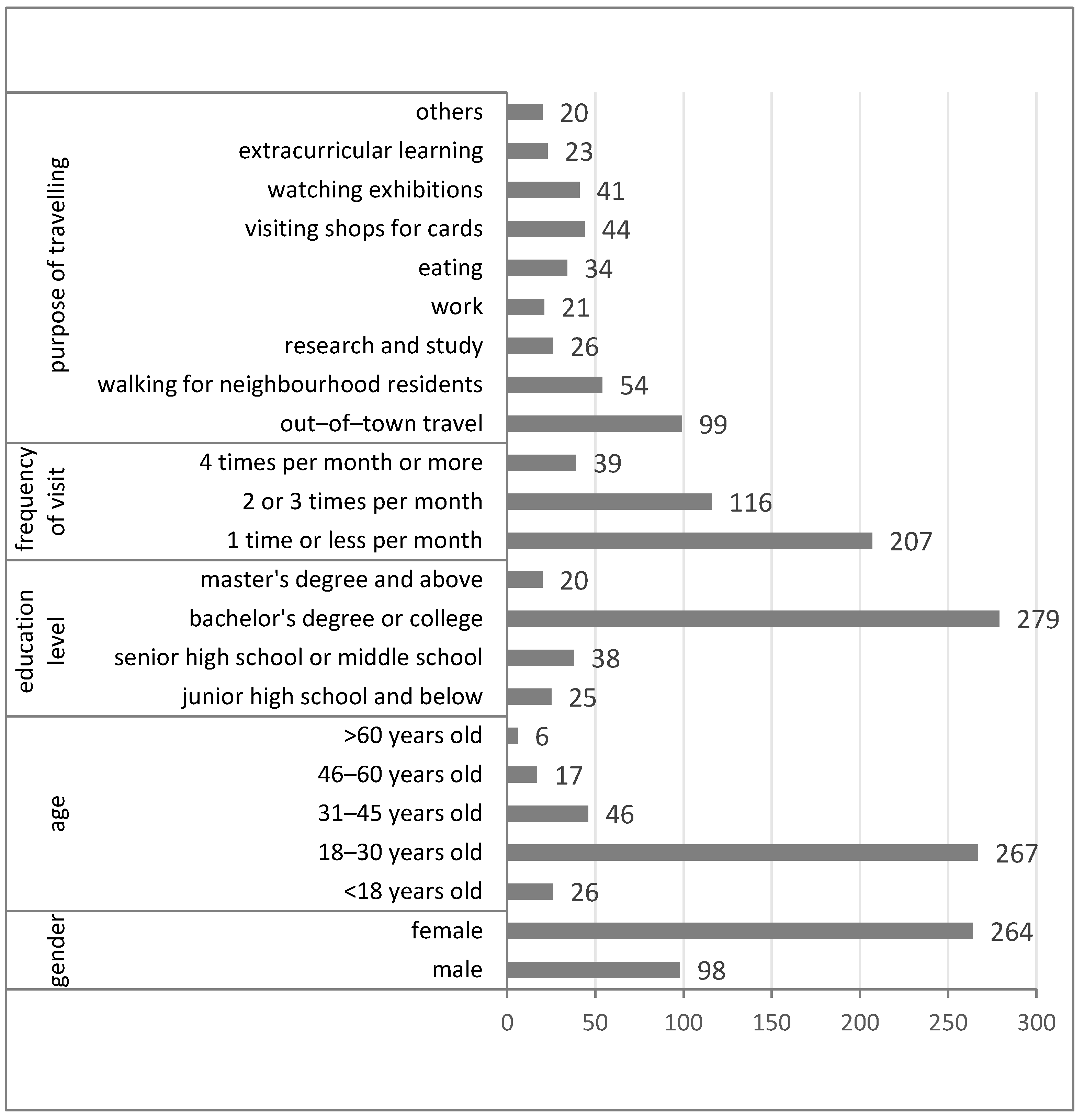

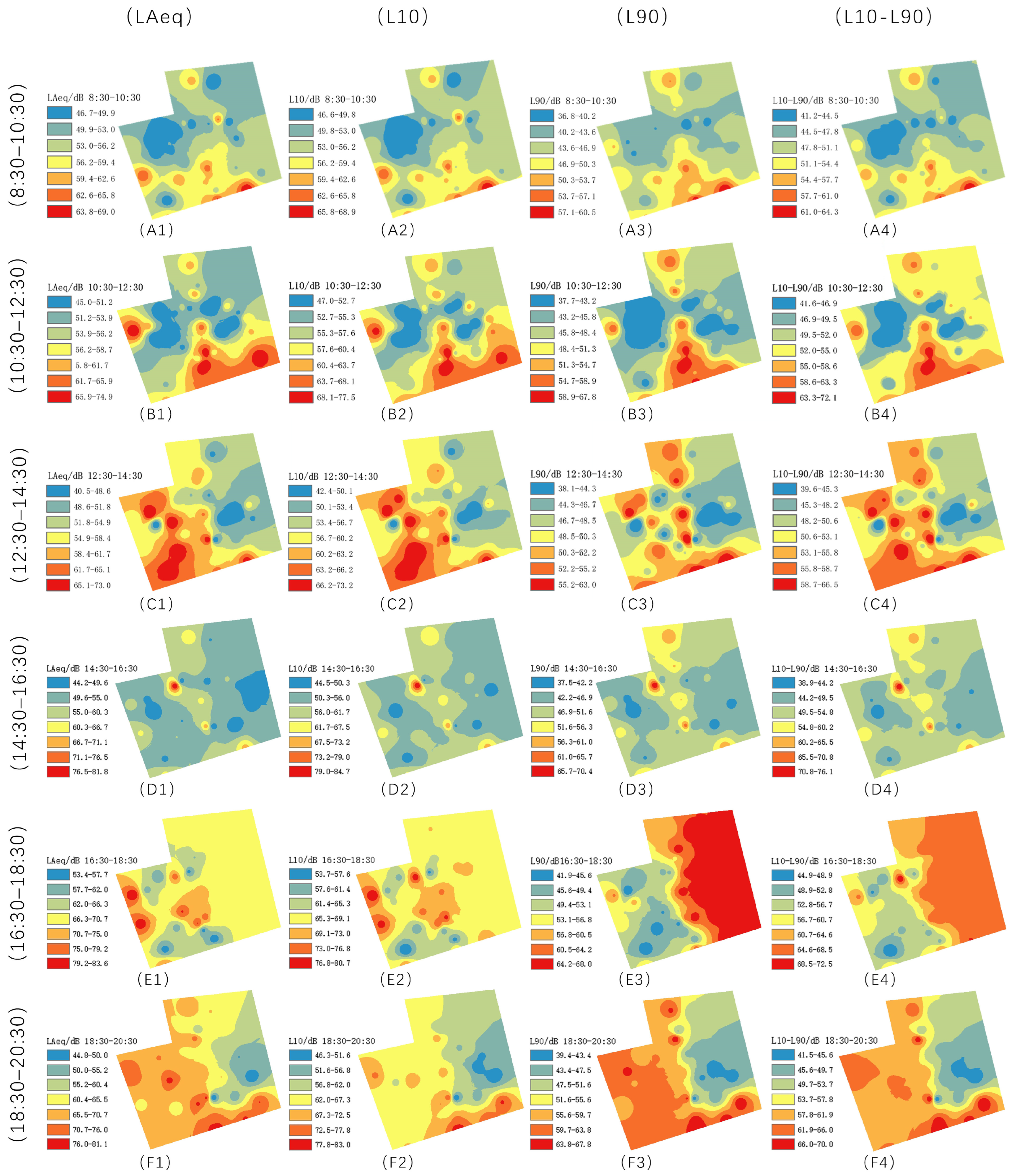
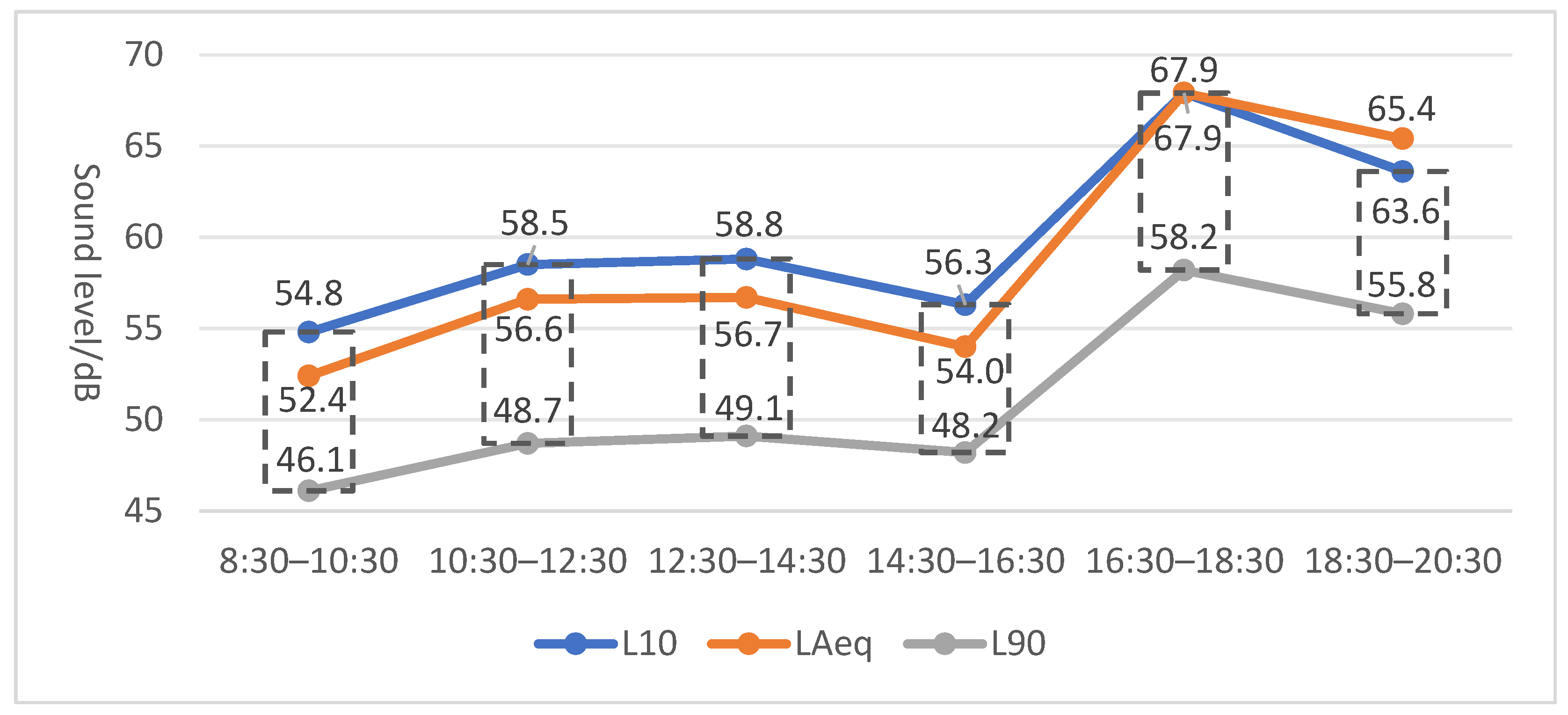
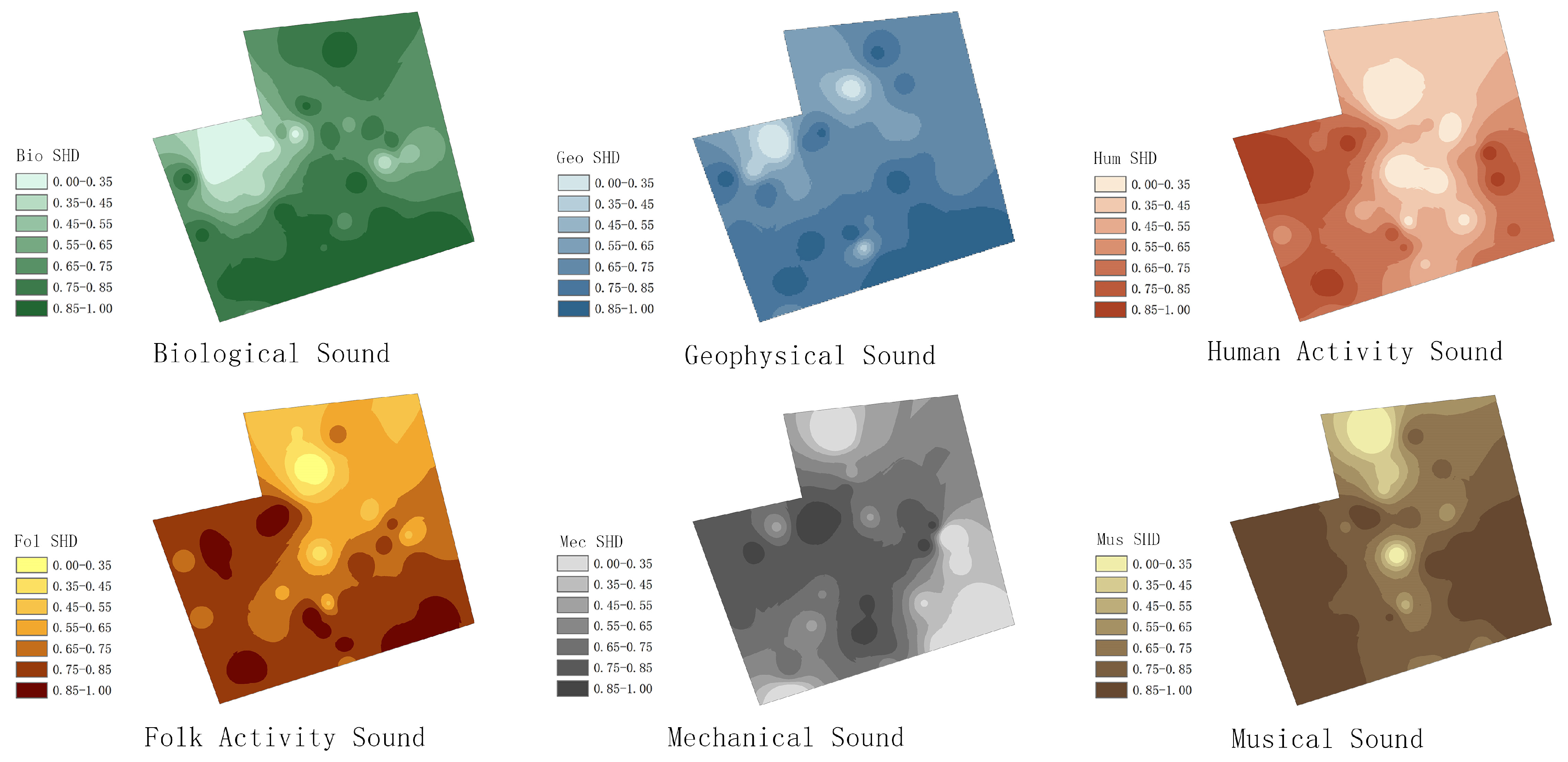
| Sound Source Category | Sound Source Name (Number) |
|---|---|
| Biological sound | Birdsong (BS) |
| Geophysical sound | Tree rustling (TR), |
| Water sounds (WS) | |
| Human activity sound | Footsteps (FS) |
| Adult talk (AT) | |
| Playful children (PC) | |
| Shops sound (SS) | |
| Horn sound (HS) | |
| Folk activity sound | Religious music sound (RM) |
| Manual tapping (MT) | |
| Specialized folk performance (SF) | |
| Mechanical sound | Construction sound (CS) |
| Urban traffic sound (UT) | |
| Machinery buzz (MB) | |
| Musical sound | Broadcast music sound (BM) |
| Street performer sound (SP) | |
| Shop music sound (SM) |
| Source Harmony | Moran’s I | z-Score | p |
|---|---|---|---|
| Biological sound | 0.436 | 3.941 ** | 0.000 |
| Geophysical sound | 0.096 | 1.083 | 0.279 |
| Human activity sound | 0.405 | 3.607 ** | 0.000 |
| Folk activity sound | 0.344 | 3.244 ** | 0.001 |
| Mechanical sound | 0.205 | 1.961 * | 0.050 |
| Musical sound | 0.139 | 1.475 | 0.140 |
| Source Harmony | Distribution Model | Sample Point |
|---|---|---|
| Biological sound | HH | L-L2, L-L3, L-Y4 |
| LL | l-f2, l-x1, l-x2, l-y1, l-y2, l-y3 | |
| HL | L-L1 | |
| Geophysical sound | HH | R-X6 |
| LL | Z2 | |
| HL | L-Y3 | |
| LH | L-Y4 | |
| Human activity sound | HH | l-f2, l-x1, l-l1, l-y3 |
| LL | z1, z2, r-x1, r-x4, r-y1, r-y2,r-y3 | |
| Folk activity sound | HH | L-F2, L-Y2 |
| LL | z1, z2, r-x1, r-y1, r-y2 | |
| LH | L-L1 | |
| Mechanical sound | HH | l-f1, l-l2, r-l3 |
| LL | R-X6 | |
| LH | L-F2 | |
| Musical sound | HH | L-Y3 |
| LL | R-Y1 | |
| HL | R-X1, R-Y2 | |
| LH | R-Y1 |
| Source Harmony | – | |||
|---|---|---|---|---|
| Biological sound | 0.061 | 0.061 | 0.298 | 0.236 |
| Geophysical sound | 0.031 | −0.021 | 0.471 | 0.013 |
| Human activity sound | −0.043 | −0.221 | −0.683 | −0.659 |
| Folk activity sound | −0.118 | −0.228 | −0.554 | −0.545 |
| Mechanical sound | 0.149 | 0.147 | −0.426 | −0.291 |
| Musical sound | −0.319 | −0.434 | −0.527 | −0.607 |
Disclaimer/Publisher’s Note: The statements, opinions and data contained in all publications are solely those of the individual author(s) and contributor(s) and not of MDPI and/or the editor(s). MDPI and/or the editor(s) disclaim responsibility for any injury to people or property resulting from any ideas, methods, instructions or products referred to in the content. |
© 2024 by the authors. Licensee MDPI, Basel, Switzerland. This article is an open access article distributed under the terms and conditions of the Creative Commons Attribution (CC BY) license (https://creativecommons.org/licenses/by/4.0/).
Share and Cite
Wu, L.; Zhang, Q.; Yan, Y.; Lan, T.; Hu, Y.; Zhang, Y.; He, T.; Ye, J. A Study on Spatiotemporal Dynamics and Spatial Dependence of Sound Source Perception in Fuzhou Historical and Cultural Districts. Buildings 2024, 14, 1753. https://doi.org/10.3390/buildings14061753
Wu L, Zhang Q, Yan Y, Lan T, Hu Y, Zhang Y, He T, Ye J. A Study on Spatiotemporal Dynamics and Spatial Dependence of Sound Source Perception in Fuzhou Historical and Cultural Districts. Buildings. 2024; 14(6):1753. https://doi.org/10.3390/buildings14061753
Chicago/Turabian StyleWu, Lin, Qiqi Zhang, Yulan Yan, Ting Lan, Yanfang Hu, Yijing Zhang, Tianyou He, and Jing Ye. 2024. "A Study on Spatiotemporal Dynamics and Spatial Dependence of Sound Source Perception in Fuzhou Historical and Cultural Districts" Buildings 14, no. 6: 1753. https://doi.org/10.3390/buildings14061753
APA StyleWu, L., Zhang, Q., Yan, Y., Lan, T., Hu, Y., Zhang, Y., He, T., & Ye, J. (2024). A Study on Spatiotemporal Dynamics and Spatial Dependence of Sound Source Perception in Fuzhou Historical and Cultural Districts. Buildings, 14(6), 1753. https://doi.org/10.3390/buildings14061753





